Economics Assignment: UniSA, Analyzing Supply, Demand & Elasticity
VerifiedAdded on 2023/06/14
|10
|1815
|497
Homework Assignment
AI Summary
This economics assignment analyzes the dynamics of the cherry market, focusing on the impact of a bumper growing season on equilibrium price and quantity. It explores the effects on related markets, such as the labor market and complementary goods markets like cakes. The assignment also calculates the price elasticity of demand for cherries, determining it to be unitary elastic. The analysis further discusses how changes in price affect consumer surplus and overall income, illustrating these concepts with supply and demand diagrams. The assignment concludes by referencing relevant academic sources to support its findings and analysis.
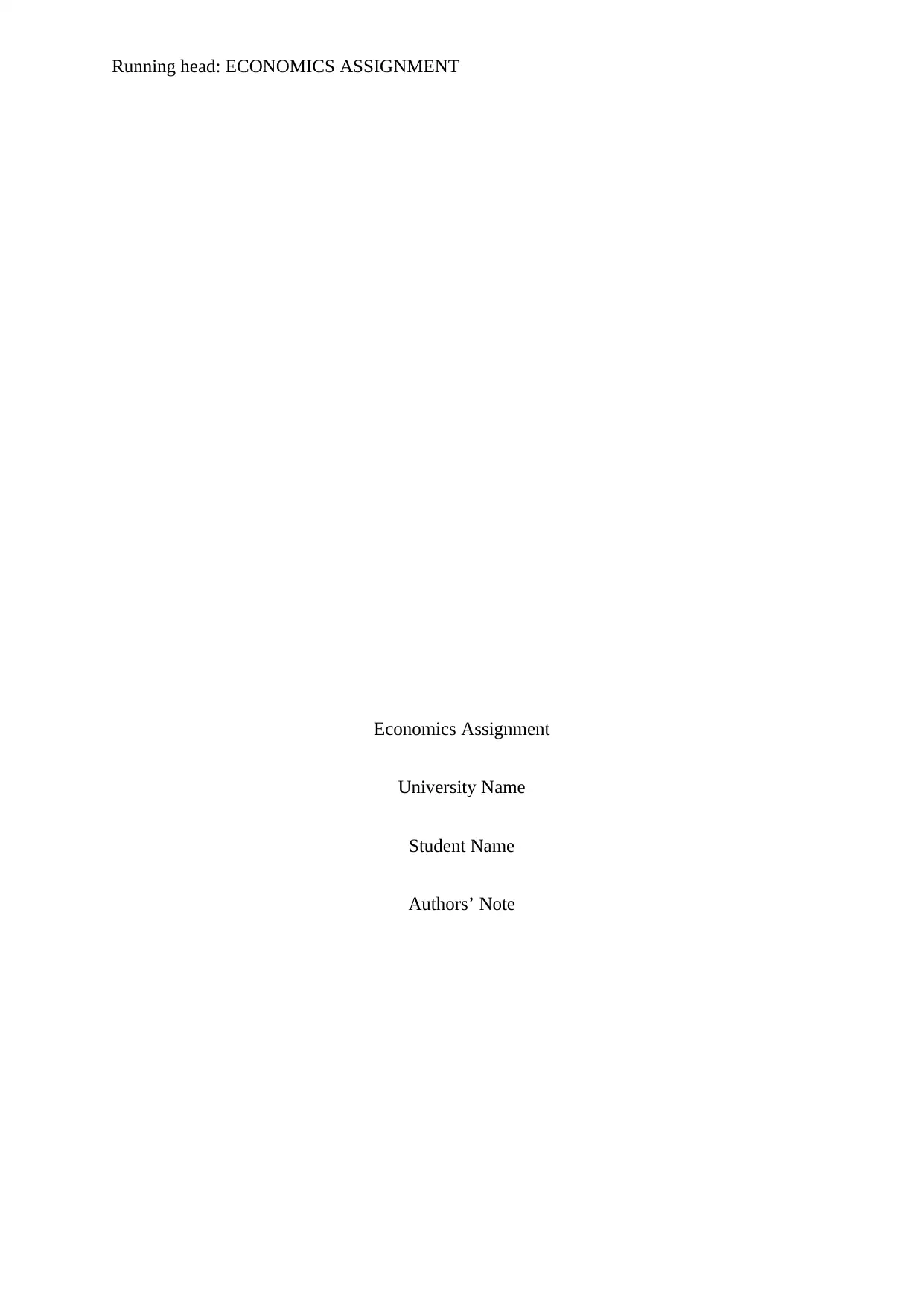
Running head: ECONOMICS ASSIGNMENT
Economics Assignment
University Name
Student Name
Authors’ Note
Economics Assignment
University Name
Student Name
Authors’ Note
Paraphrase This Document
Need a fresh take? Get an instant paraphrase of this document with our AI Paraphraser
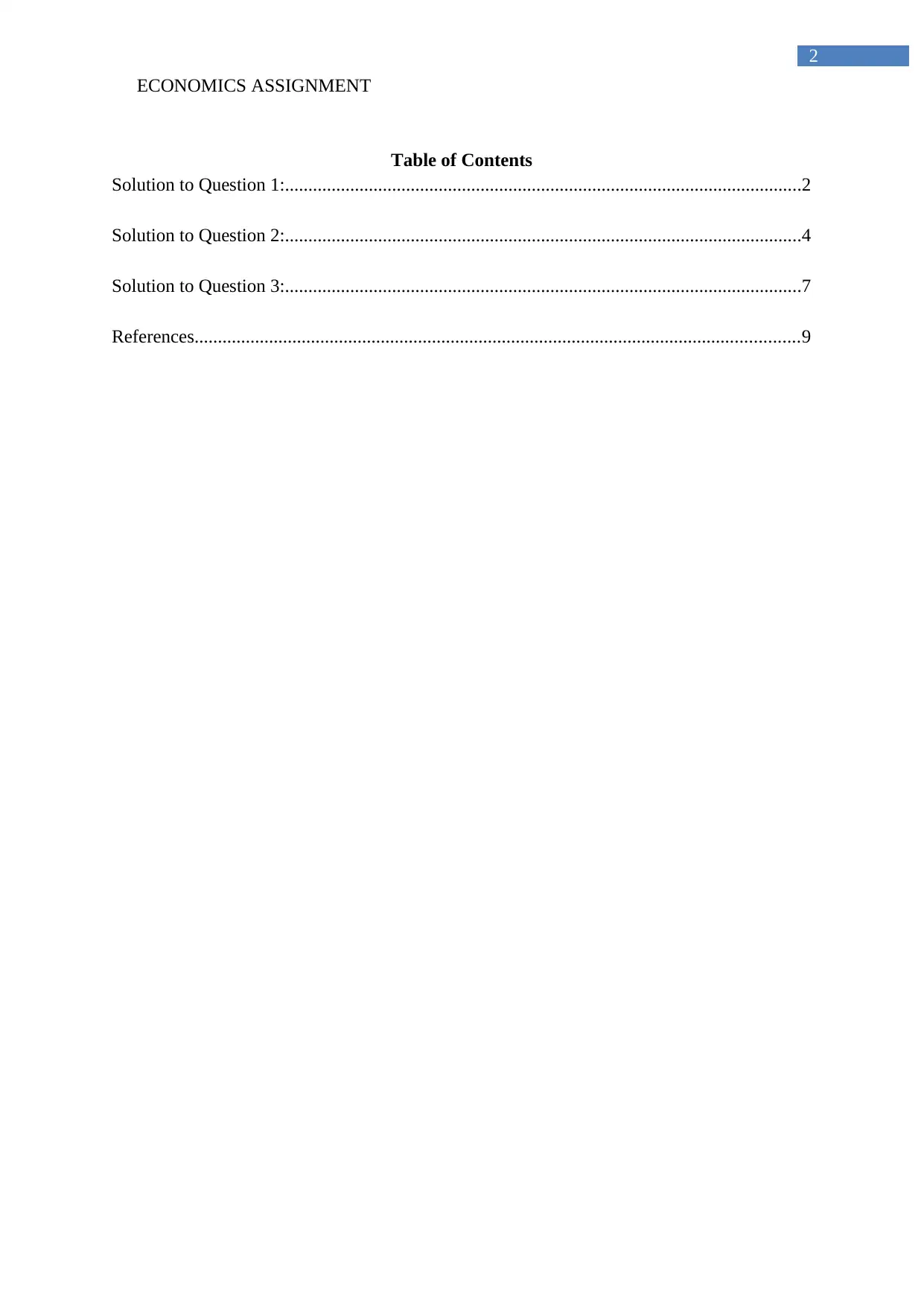
2
ECONOMICS ASSIGNMENT
Table of Contents
Solution to Question 1:...............................................................................................................2
Solution to Question 2:...............................................................................................................4
Solution to Question 3:...............................................................................................................7
References..................................................................................................................................9
ECONOMICS ASSIGNMENT
Table of Contents
Solution to Question 1:...............................................................................................................2
Solution to Question 2:...............................................................................................................4
Solution to Question 3:...............................................................................................................7
References..................................................................................................................................9
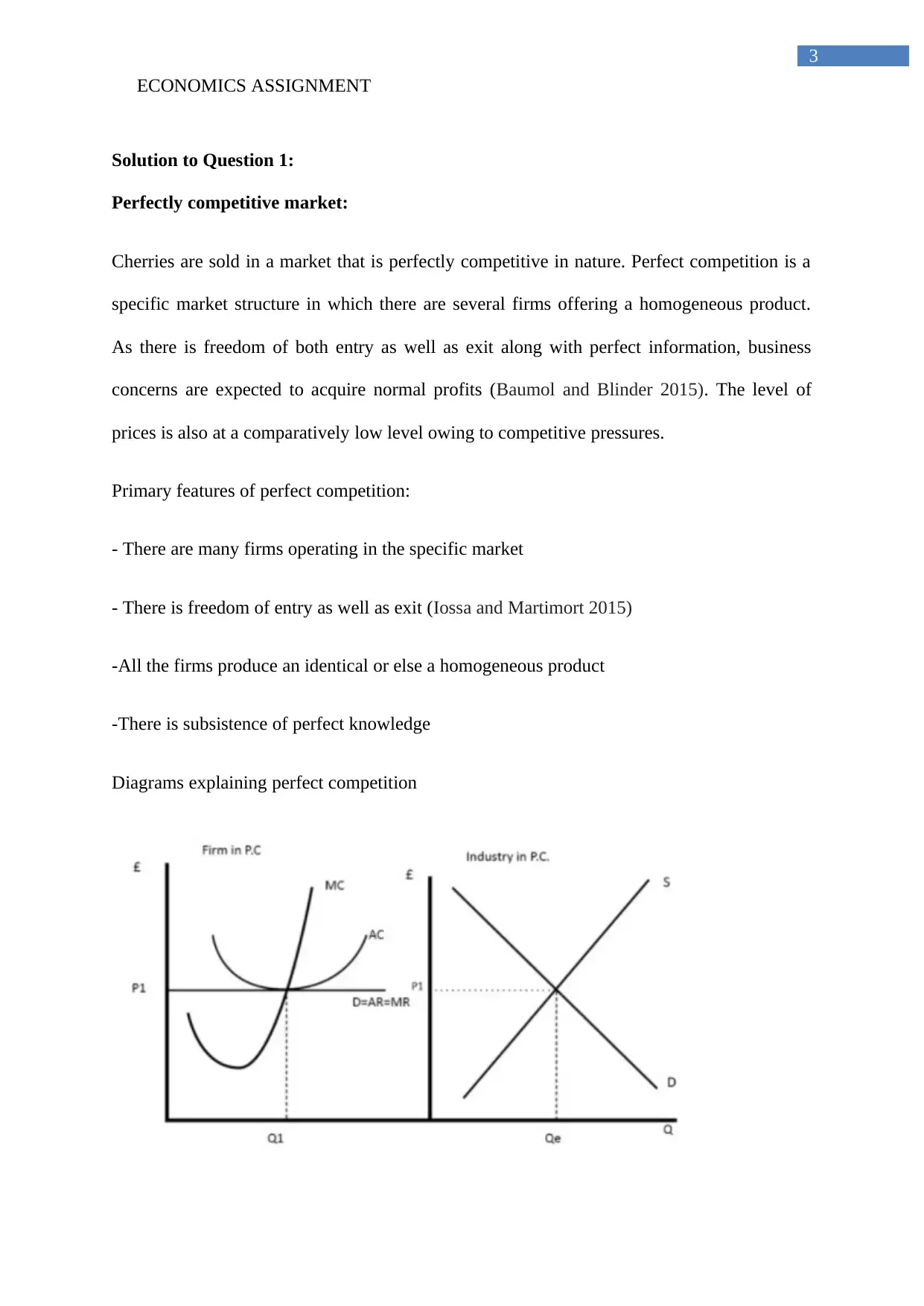
3
ECONOMICS ASSIGNMENT
Solution to Question 1:
Perfectly competitive market:
Cherries are sold in a market that is perfectly competitive in nature. Perfect competition is a
specific market structure in which there are several firms offering a homogeneous product.
As there is freedom of both entry as well as exit along with perfect information, business
concerns are expected to acquire normal profits (Baumol and Blinder 2015). The level of
prices is also at a comparatively low level owing to competitive pressures.
Primary features of perfect competition:
- There are many firms operating in the specific market
- There is freedom of entry as well as exit (Iossa and Martimort 2015)
-All the firms produce an identical or else a homogeneous product
-There is subsistence of perfect knowledge
Diagrams explaining perfect competition
ECONOMICS ASSIGNMENT
Solution to Question 1:
Perfectly competitive market:
Cherries are sold in a market that is perfectly competitive in nature. Perfect competition is a
specific market structure in which there are several firms offering a homogeneous product.
As there is freedom of both entry as well as exit along with perfect information, business
concerns are expected to acquire normal profits (Baumol and Blinder 2015). The level of
prices is also at a comparatively low level owing to competitive pressures.
Primary features of perfect competition:
- There are many firms operating in the specific market
- There is freedom of entry as well as exit (Iossa and Martimort 2015)
-All the firms produce an identical or else a homogeneous product
-There is subsistence of perfect knowledge
Diagrams explaining perfect competition
⊘ This is a preview!⊘
Do you want full access?
Subscribe today to unlock all pages.

Trusted by 1+ million students worldwide
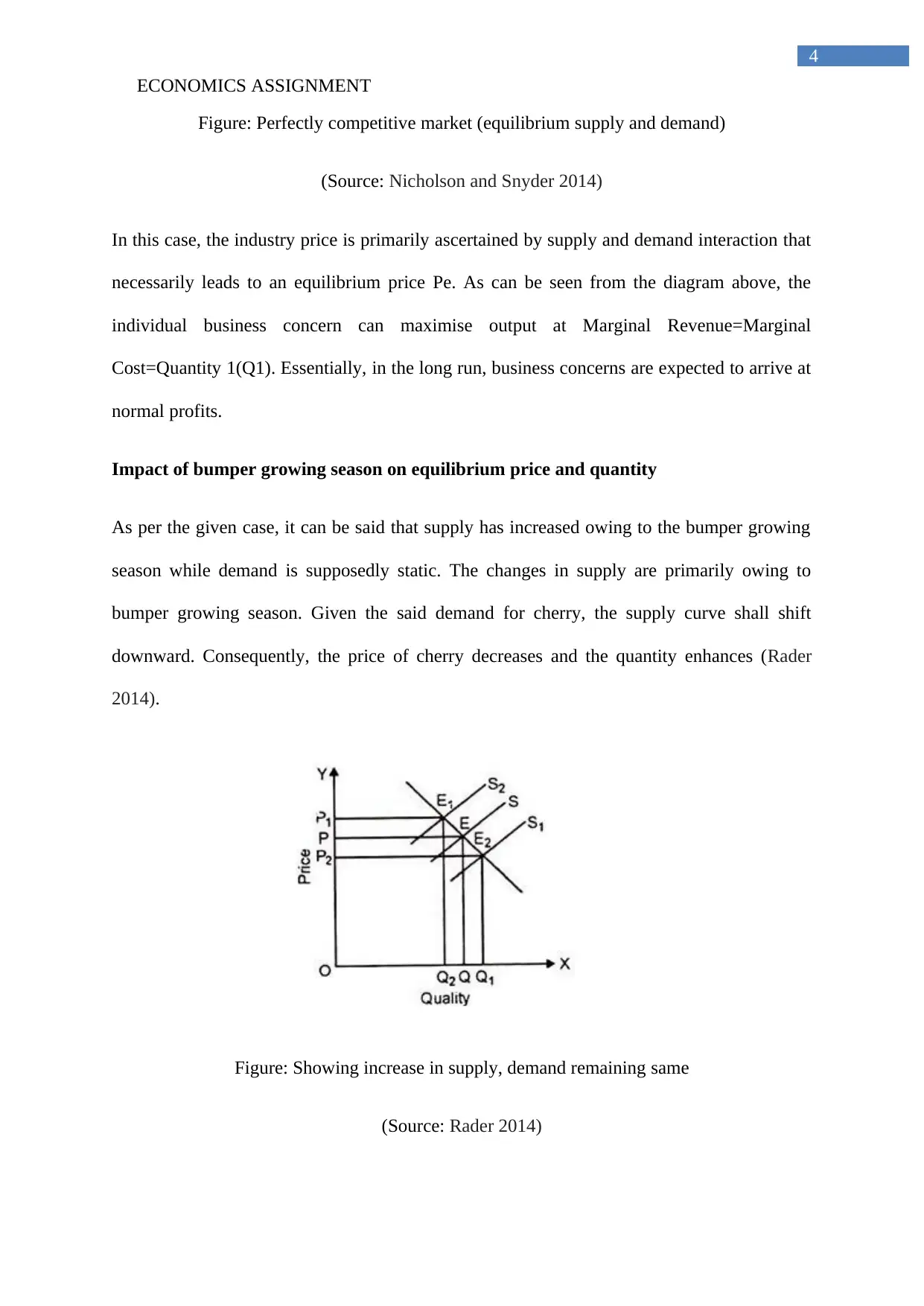
4
ECONOMICS ASSIGNMENT
Figure: Perfectly competitive market (equilibrium supply and demand)
(Source: Nicholson and Snyder 2014)
In this case, the industry price is primarily ascertained by supply and demand interaction that
necessarily leads to an equilibrium price Pe. As can be seen from the diagram above, the
individual business concern can maximise output at Marginal Revenue=Marginal
Cost=Quantity 1(Q1). Essentially, in the long run, business concerns are expected to arrive at
normal profits.
Impact of bumper growing season on equilibrium price and quantity
As per the given case, it can be said that supply has increased owing to the bumper growing
season while demand is supposedly static. The changes in supply are primarily owing to
bumper growing season. Given the said demand for cherry, the supply curve shall shift
downward. Consequently, the price of cherry decreases and the quantity enhances (Rader
2014).
Figure: Showing increase in supply, demand remaining same
(Source: Rader 2014)
ECONOMICS ASSIGNMENT
Figure: Perfectly competitive market (equilibrium supply and demand)
(Source: Nicholson and Snyder 2014)
In this case, the industry price is primarily ascertained by supply and demand interaction that
necessarily leads to an equilibrium price Pe. As can be seen from the diagram above, the
individual business concern can maximise output at Marginal Revenue=Marginal
Cost=Quantity 1(Q1). Essentially, in the long run, business concerns are expected to arrive at
normal profits.
Impact of bumper growing season on equilibrium price and quantity
As per the given case, it can be said that supply has increased owing to the bumper growing
season while demand is supposedly static. The changes in supply are primarily owing to
bumper growing season. Given the said demand for cherry, the supply curve shall shift
downward. Consequently, the price of cherry decreases and the quantity enhances (Rader
2014).
Figure: Showing increase in supply, demand remaining same
(Source: Rader 2014)
Paraphrase This Document
Need a fresh take? Get an instant paraphrase of this document with our AI Paraphraser
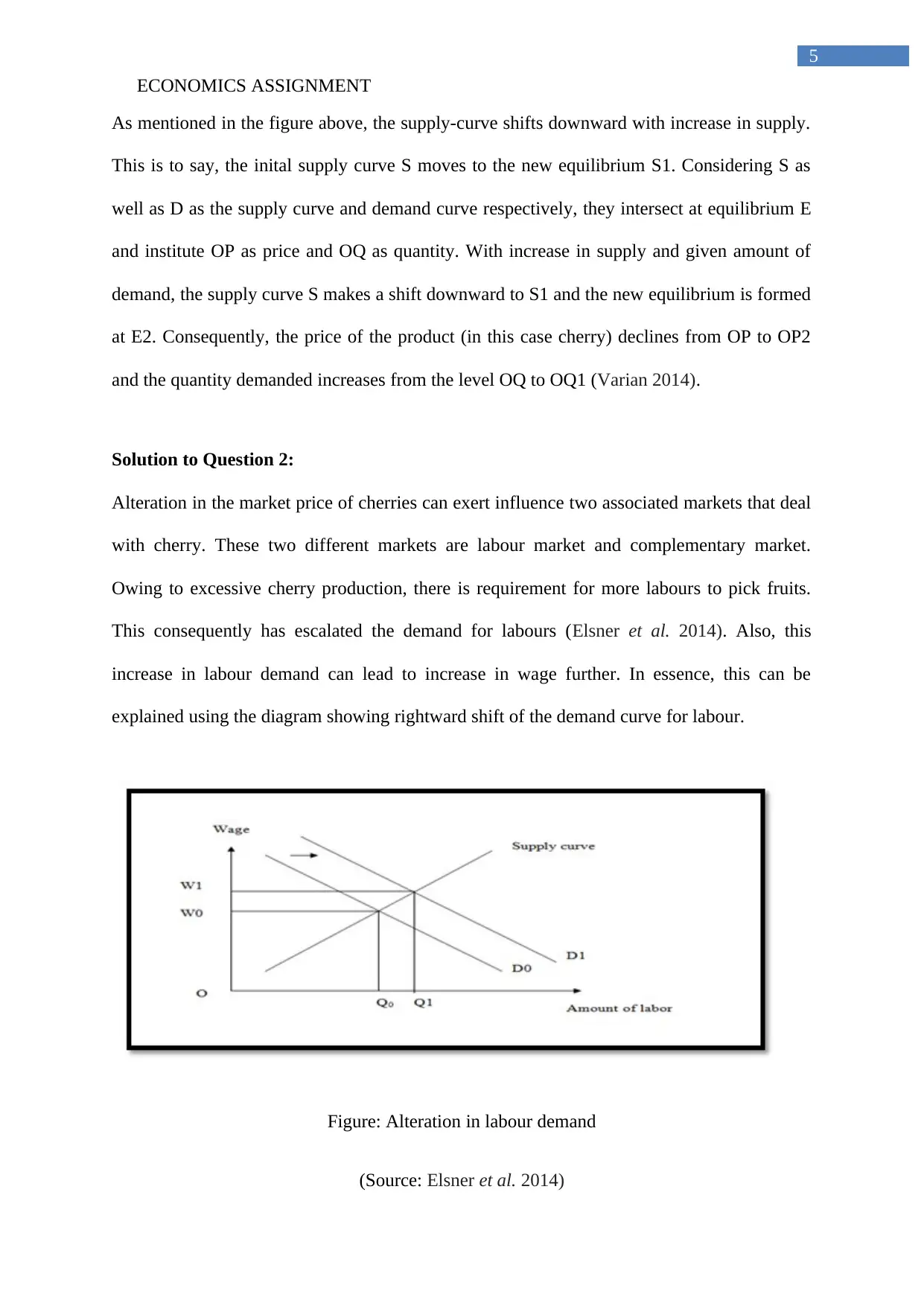
5
ECONOMICS ASSIGNMENT
As mentioned in the figure above, the supply-curve shifts downward with increase in supply.
This is to say, the inital supply curve S moves to the new equilibrium S1. Considering S as
well as D as the supply curve and demand curve respectively, they intersect at equilibrium E
and institute OP as price and OQ as quantity. With increase in supply and given amount of
demand, the supply curve S makes a shift downward to S1 and the new equilibrium is formed
at E2. Consequently, the price of the product (in this case cherry) declines from OP to OP2
and the quantity demanded increases from the level OQ to OQ1 (Varian 2014).
Solution to Question 2:
Alteration in the market price of cherries can exert influence two associated markets that deal
with cherry. These two different markets are labour market and complementary market.
Owing to excessive cherry production, there is requirement for more labours to pick fruits.
This consequently has escalated the demand for labours (Elsner et al. 2014). Also, this
increase in labour demand can lead to increase in wage further. In essence, this can be
explained using the diagram showing rightward shift of the demand curve for labour.
Figure: Alteration in labour demand
(Source: Elsner et al. 2014)
ECONOMICS ASSIGNMENT
As mentioned in the figure above, the supply-curve shifts downward with increase in supply.
This is to say, the inital supply curve S moves to the new equilibrium S1. Considering S as
well as D as the supply curve and demand curve respectively, they intersect at equilibrium E
and institute OP as price and OQ as quantity. With increase in supply and given amount of
demand, the supply curve S makes a shift downward to S1 and the new equilibrium is formed
at E2. Consequently, the price of the product (in this case cherry) declines from OP to OP2
and the quantity demanded increases from the level OQ to OQ1 (Varian 2014).
Solution to Question 2:
Alteration in the market price of cherries can exert influence two associated markets that deal
with cherry. These two different markets are labour market and complementary market.
Owing to excessive cherry production, there is requirement for more labours to pick fruits.
This consequently has escalated the demand for labours (Elsner et al. 2014). Also, this
increase in labour demand can lead to increase in wage further. In essence, this can be
explained using the diagram showing rightward shift of the demand curve for labour.
Figure: Alteration in labour demand
(Source: Elsner et al. 2014)
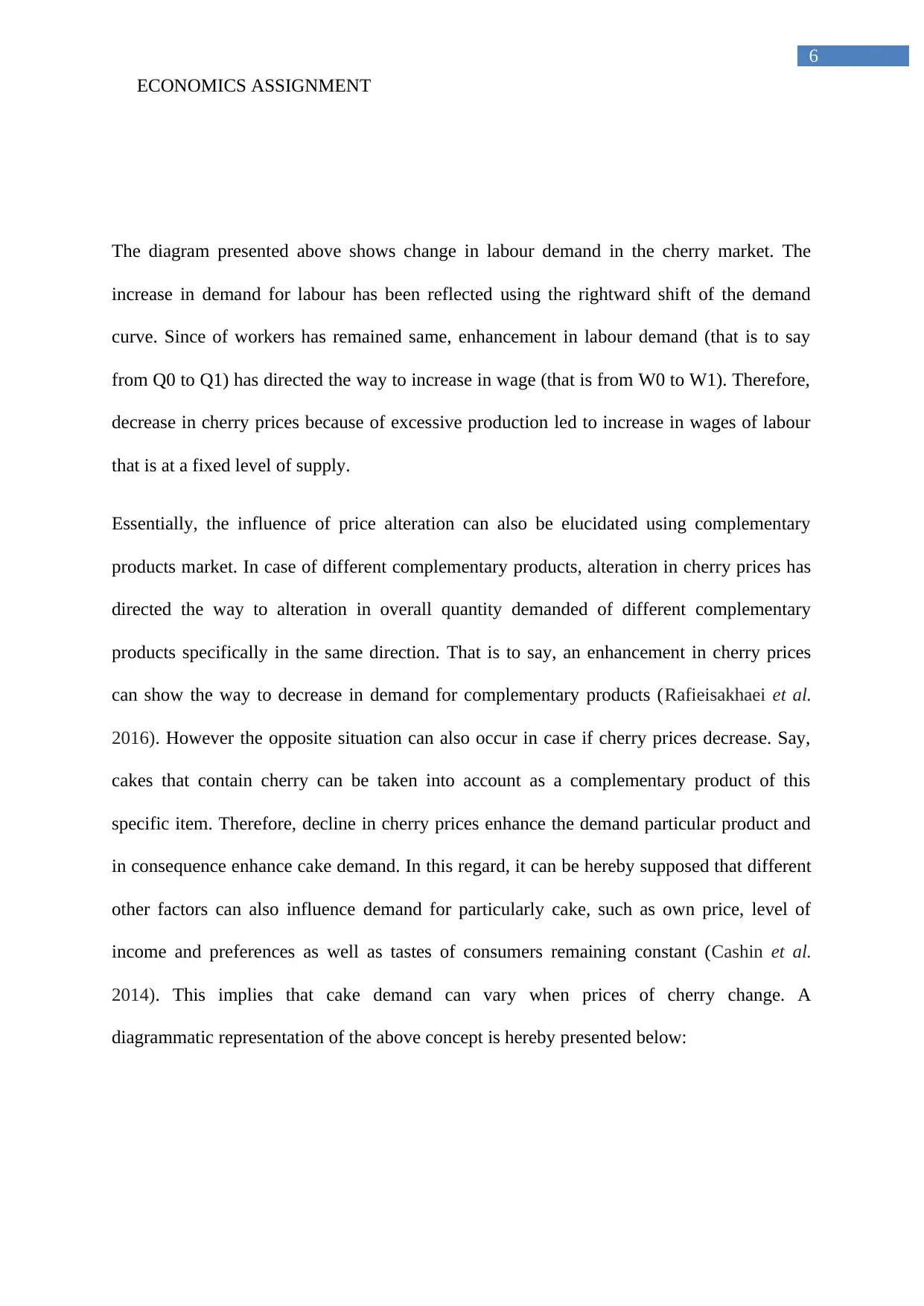
6
ECONOMICS ASSIGNMENT
The diagram presented above shows change in labour demand in the cherry market. The
increase in demand for labour has been reflected using the rightward shift of the demand
curve. Since of workers has remained same, enhancement in labour demand (that is to say
from Q0 to Q1) has directed the way to increase in wage (that is from W0 to W1). Therefore,
decrease in cherry prices because of excessive production led to increase in wages of labour
that is at a fixed level of supply.
Essentially, the influence of price alteration can also be elucidated using complementary
products market. In case of different complementary products, alteration in cherry prices has
directed the way to alteration in overall quantity demanded of different complementary
products specifically in the same direction. That is to say, an enhancement in cherry prices
can show the way to decrease in demand for complementary products (Rafieisakhaei et al.
2016). However the opposite situation can also occur in case if cherry prices decrease. Say,
cakes that contain cherry can be taken into account as a complementary product of this
specific item. Therefore, decline in cherry prices enhance the demand particular product and
in consequence enhance cake demand. In this regard, it can be hereby supposed that different
other factors can also influence demand for particularly cake, such as own price, level of
income and preferences as well as tastes of consumers remaining constant (Cashin et al.
2014). This implies that cake demand can vary when prices of cherry change. A
diagrammatic representation of the above concept is hereby presented below:
ECONOMICS ASSIGNMENT
The diagram presented above shows change in labour demand in the cherry market. The
increase in demand for labour has been reflected using the rightward shift of the demand
curve. Since of workers has remained same, enhancement in labour demand (that is to say
from Q0 to Q1) has directed the way to increase in wage (that is from W0 to W1). Therefore,
decrease in cherry prices because of excessive production led to increase in wages of labour
that is at a fixed level of supply.
Essentially, the influence of price alteration can also be elucidated using complementary
products market. In case of different complementary products, alteration in cherry prices has
directed the way to alteration in overall quantity demanded of different complementary
products specifically in the same direction. That is to say, an enhancement in cherry prices
can show the way to decrease in demand for complementary products (Rafieisakhaei et al.
2016). However the opposite situation can also occur in case if cherry prices decrease. Say,
cakes that contain cherry can be taken into account as a complementary product of this
specific item. Therefore, decline in cherry prices enhance the demand particular product and
in consequence enhance cake demand. In this regard, it can be hereby supposed that different
other factors can also influence demand for particularly cake, such as own price, level of
income and preferences as well as tastes of consumers remaining constant (Cashin et al.
2014). This implies that cake demand can vary when prices of cherry change. A
diagrammatic representation of the above concept is hereby presented below:
⊘ This is a preview!⊘
Do you want full access?
Subscribe today to unlock all pages.

Trusted by 1+ million students worldwide
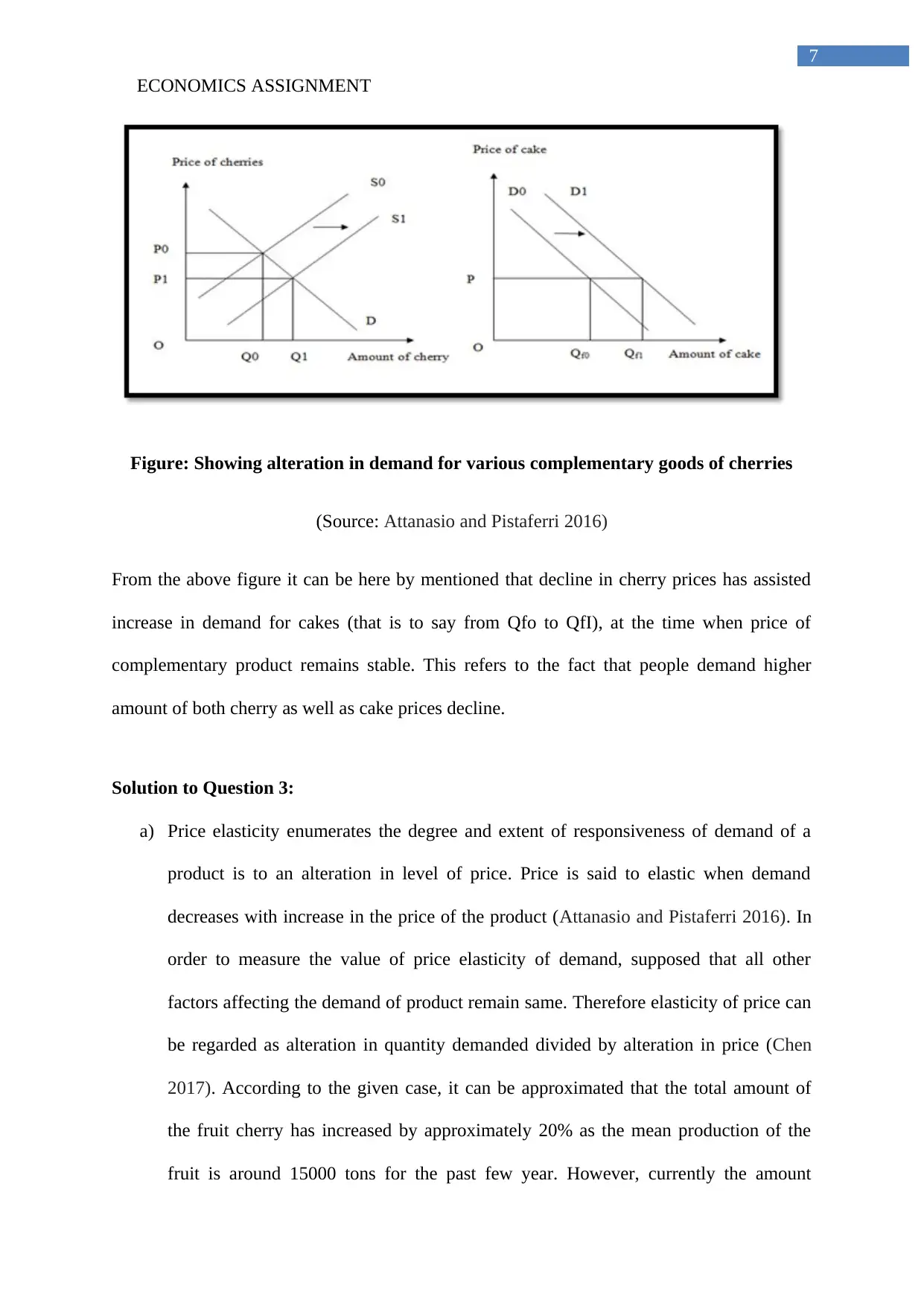
7
ECONOMICS ASSIGNMENT
Figure: Showing alteration in demand for various complementary goods of cherries
(Source: Attanasio and Pistaferri 2016)
From the above figure it can be here by mentioned that decline in cherry prices has assisted
increase in demand for cakes (that is to say from Qfo to QfI), at the time when price of
complementary product remains stable. This refers to the fact that people demand higher
amount of both cherry as well as cake prices decline.
Solution to Question 3:
a) Price elasticity enumerates the degree and extent of responsiveness of demand of a
product is to an alteration in level of price. Price is said to elastic when demand
decreases with increase in the price of the product (Attanasio and Pistaferri 2016). In
order to measure the value of price elasticity of demand, supposed that all other
factors affecting the demand of product remain same. Therefore elasticity of price can
be regarded as alteration in quantity demanded divided by alteration in price (Chen
2017). According to the given case, it can be approximated that the total amount of
the fruit cherry has increased by approximately 20% as the mean production of the
fruit is around 15000 tons for the past few year. However, currently the amount
ECONOMICS ASSIGNMENT
Figure: Showing alteration in demand for various complementary goods of cherries
(Source: Attanasio and Pistaferri 2016)
From the above figure it can be here by mentioned that decline in cherry prices has assisted
increase in demand for cakes (that is to say from Qfo to QfI), at the time when price of
complementary product remains stable. This refers to the fact that people demand higher
amount of both cherry as well as cake prices decline.
Solution to Question 3:
a) Price elasticity enumerates the degree and extent of responsiveness of demand of a
product is to an alteration in level of price. Price is said to elastic when demand
decreases with increase in the price of the product (Attanasio and Pistaferri 2016). In
order to measure the value of price elasticity of demand, supposed that all other
factors affecting the demand of product remain same. Therefore elasticity of price can
be regarded as alteration in quantity demanded divided by alteration in price (Chen
2017). According to the given case, it can be approximated that the total amount of
the fruit cherry has increased by approximately 20% as the mean production of the
fruit is around 15000 tons for the past few year. However, currently the amount
Paraphrase This Document
Need a fresh take? Get an instant paraphrase of this document with our AI Paraphraser
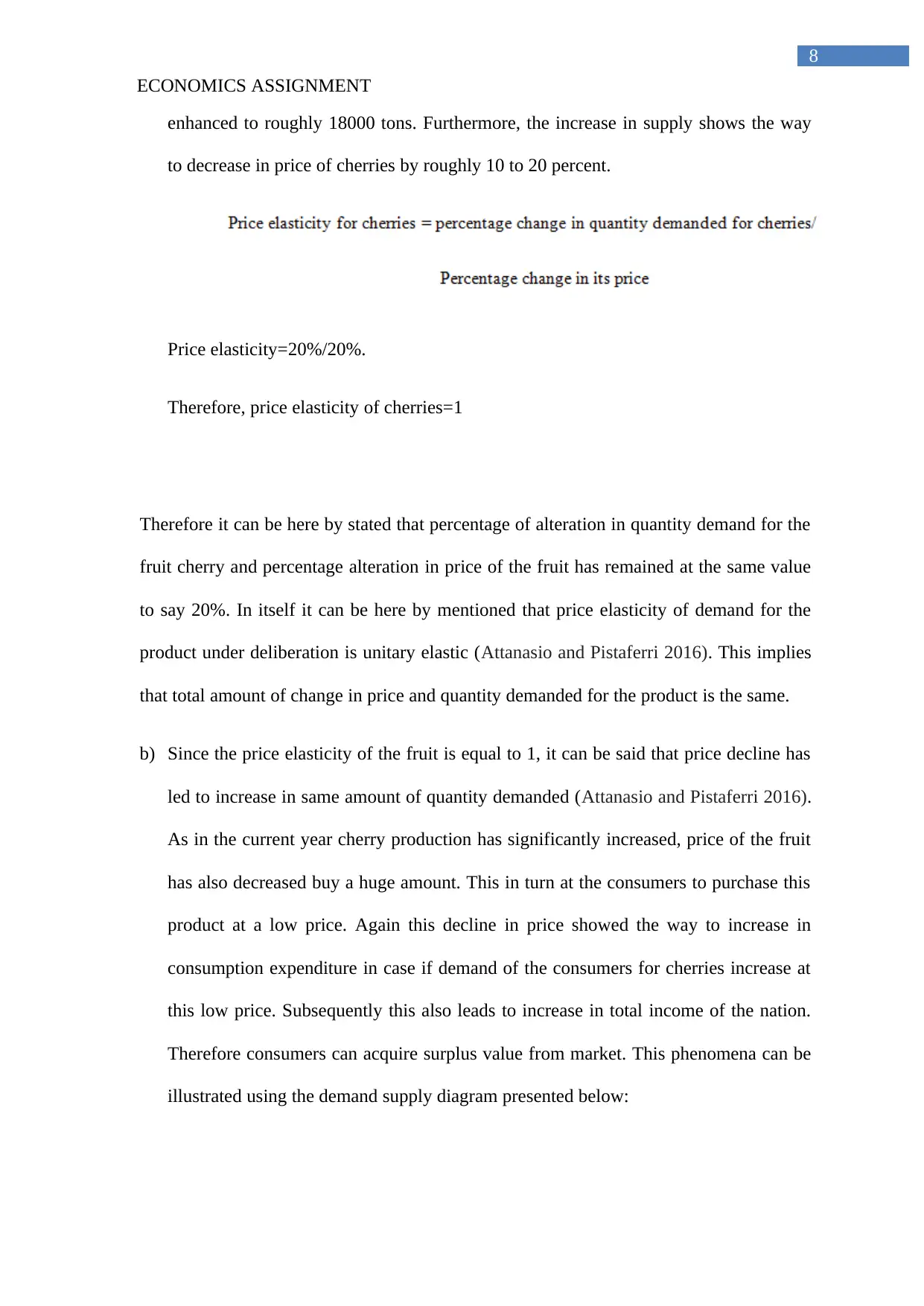
8
ECONOMICS ASSIGNMENT
enhanced to roughly 18000 tons. Furthermore, the increase in supply shows the way
to decrease in price of cherries by roughly 10 to 20 percent.
Price elasticity=20%/20%.
Therefore, price elasticity of cherries=1
Therefore it can be here by stated that percentage of alteration in quantity demand for the
fruit cherry and percentage alteration in price of the fruit has remained at the same value
to say 20%. In itself it can be here by mentioned that price elasticity of demand for the
product under deliberation is unitary elastic (Attanasio and Pistaferri 2016). This implies
that total amount of change in price and quantity demanded for the product is the same.
b) Since the price elasticity of the fruit is equal to 1, it can be said that price decline has
led to increase in same amount of quantity demanded (Attanasio and Pistaferri 2016).
As in the current year cherry production has significantly increased, price of the fruit
has also decreased buy a huge amount. This in turn at the consumers to purchase this
product at a low price. Again this decline in price showed the way to increase in
consumption expenditure in case if demand of the consumers for cherries increase at
this low price. Subsequently this also leads to increase in total income of the nation.
Therefore consumers can acquire surplus value from market. This phenomena can be
illustrated using the demand supply diagram presented below:
ECONOMICS ASSIGNMENT
enhanced to roughly 18000 tons. Furthermore, the increase in supply shows the way
to decrease in price of cherries by roughly 10 to 20 percent.
Price elasticity=20%/20%.
Therefore, price elasticity of cherries=1
Therefore it can be here by stated that percentage of alteration in quantity demand for the
fruit cherry and percentage alteration in price of the fruit has remained at the same value
to say 20%. In itself it can be here by mentioned that price elasticity of demand for the
product under deliberation is unitary elastic (Attanasio and Pistaferri 2016). This implies
that total amount of change in price and quantity demanded for the product is the same.
b) Since the price elasticity of the fruit is equal to 1, it can be said that price decline has
led to increase in same amount of quantity demanded (Attanasio and Pistaferri 2016).
As in the current year cherry production has significantly increased, price of the fruit
has also decreased buy a huge amount. This in turn at the consumers to purchase this
product at a low price. Again this decline in price showed the way to increase in
consumption expenditure in case if demand of the consumers for cherries increase at
this low price. Subsequently this also leads to increase in total income of the nation.
Therefore consumers can acquire surplus value from market. This phenomena can be
illustrated using the demand supply diagram presented below:
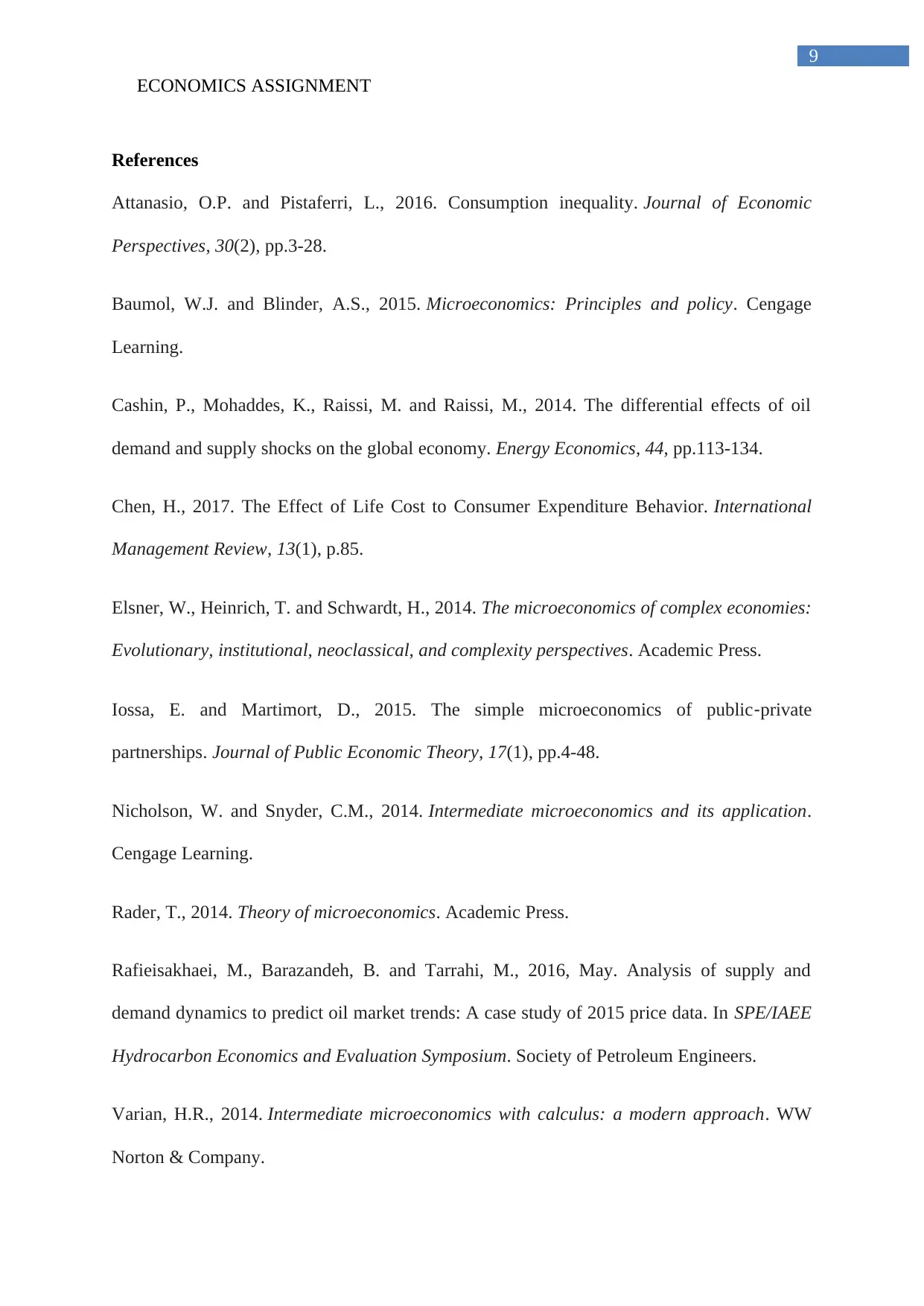
9
ECONOMICS ASSIGNMENT
References
Attanasio, O.P. and Pistaferri, L., 2016. Consumption inequality. Journal of Economic
Perspectives, 30(2), pp.3-28.
Baumol, W.J. and Blinder, A.S., 2015. Microeconomics: Principles and policy. Cengage
Learning.
Cashin, P., Mohaddes, K., Raissi, M. and Raissi, M., 2014. The differential effects of oil
demand and supply shocks on the global economy. Energy Economics, 44, pp.113-134.
Chen, H., 2017. The Effect of Life Cost to Consumer Expenditure Behavior. International
Management Review, 13(1), p.85.
Elsner, W., Heinrich, T. and Schwardt, H., 2014. The microeconomics of complex economies:
Evolutionary, institutional, neoclassical, and complexity perspectives. Academic Press.
Iossa, E. and Martimort, D., 2015. The simple microeconomics of public‐private
partnerships. Journal of Public Economic Theory, 17(1), pp.4-48.
Nicholson, W. and Snyder, C.M., 2014. Intermediate microeconomics and its application.
Cengage Learning.
Rader, T., 2014. Theory of microeconomics. Academic Press.
Rafieisakhaei, M., Barazandeh, B. and Tarrahi, M., 2016, May. Analysis of supply and
demand dynamics to predict oil market trends: A case study of 2015 price data. In SPE/IAEE
Hydrocarbon Economics and Evaluation Symposium. Society of Petroleum Engineers.
Varian, H.R., 2014. Intermediate microeconomics with calculus: a modern approach. WW
Norton & Company.
ECONOMICS ASSIGNMENT
References
Attanasio, O.P. and Pistaferri, L., 2016. Consumption inequality. Journal of Economic
Perspectives, 30(2), pp.3-28.
Baumol, W.J. and Blinder, A.S., 2015. Microeconomics: Principles and policy. Cengage
Learning.
Cashin, P., Mohaddes, K., Raissi, M. and Raissi, M., 2014. The differential effects of oil
demand and supply shocks on the global economy. Energy Economics, 44, pp.113-134.
Chen, H., 2017. The Effect of Life Cost to Consumer Expenditure Behavior. International
Management Review, 13(1), p.85.
Elsner, W., Heinrich, T. and Schwardt, H., 2014. The microeconomics of complex economies:
Evolutionary, institutional, neoclassical, and complexity perspectives. Academic Press.
Iossa, E. and Martimort, D., 2015. The simple microeconomics of public‐private
partnerships. Journal of Public Economic Theory, 17(1), pp.4-48.
Nicholson, W. and Snyder, C.M., 2014. Intermediate microeconomics and its application.
Cengage Learning.
Rader, T., 2014. Theory of microeconomics. Academic Press.
Rafieisakhaei, M., Barazandeh, B. and Tarrahi, M., 2016, May. Analysis of supply and
demand dynamics to predict oil market trends: A case study of 2015 price data. In SPE/IAEE
Hydrocarbon Economics and Evaluation Symposium. Society of Petroleum Engineers.
Varian, H.R., 2014. Intermediate microeconomics with calculus: a modern approach. WW
Norton & Company.
⊘ This is a preview!⊘
Do you want full access?
Subscribe today to unlock all pages.

Trusted by 1+ million students worldwide

10
ECONOMICS ASSIGNMENT
Figure: Figure showing consumer surplus
Source: created by author
Essentially consumer surplus in the market of the fruit is represented in the above
diagram by the area of triangle (ABPe). In order to purchase one unit of the fruit
cherry, consumers pay amount Pe whilst concerned individuals want to expend
amount A for equal output amount. The time when cherry price decreases, people in
order to buy same amount have the need to disburse comparatively fever amount of
money. Therefore, this phenomenon helps consumers to acquire higher amount of
consumer surplus. Subsequently this influences consumers to demand the fruit by
greater amount overall demand for this fruit further.
ECONOMICS ASSIGNMENT
Figure: Figure showing consumer surplus
Source: created by author
Essentially consumer surplus in the market of the fruit is represented in the above
diagram by the area of triangle (ABPe). In order to purchase one unit of the fruit
cherry, consumers pay amount Pe whilst concerned individuals want to expend
amount A for equal output amount. The time when cherry price decreases, people in
order to buy same amount have the need to disburse comparatively fever amount of
money. Therefore, this phenomenon helps consumers to acquire higher amount of
consumer surplus. Subsequently this influences consumers to demand the fruit by
greater amount overall demand for this fruit further.
1 out of 10
Related Documents
Your All-in-One AI-Powered Toolkit for Academic Success.
+13062052269
info@desklib.com
Available 24*7 on WhatsApp / Email
![[object Object]](/_next/static/media/star-bottom.7253800d.svg)
Unlock your academic potential
Copyright © 2020–2025 A2Z Services. All Rights Reserved. Developed and managed by ZUCOL.





